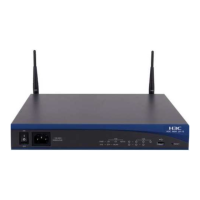port hybrid untagged vlan 50
#
bgp 65410
peer 10.1.1.2 as-number 100
peer 10.2.1.2 as-number 100
#
ipv4-family unicast
undo synchronization
network 10.3.1.0 255.255.255.0
import-route direct
peer 10.1.1.2 enable
peer 10.2.1.2 enable
#
return
3.14.10 Example for Configuring Double RRs to Optimize VPN
Backbone Layer
Networking Requirements
In VPN deployment, to improve the reliability, you can configure VPN instances with double
RRs. That is, select two Ps in the same AS as two RRs. They are backup devices of each other,
reflecting routes of the public network and VPNv4.
Figure 3-12 Networking diagram for configuring double reflectors to optimize VPN backbone
layer
CE1 CE2
PE2
P2
P1
PE1
GE1/0/0
GE1/0/0
GE2/0/0 GE1/0/0
GE1/0/0
GE2/0/0
GE3/0/0
GE3/0/0
GE3/0/0 GE3/0/0
GE2/0/0
GE1/0/0
GE2/0/0
GE1/0/0
Loopback1
2.2.2.9/32
Loopback1
3.3.3.9/32
Loopback1
1.1.1.9/32
Loopback1
4.4.4.9/32
AS100
AS65410 AS65420
S9300
Interface VLANIF interface IP address
PE1 GigabitEthernet1/0/0 VLANIF 10 100.1.1.1/24
GigabitEthernet2/0/0 VLANIF 60 10.1.1.2/24
GigabitEthernet3/0/0 VLANIF 40 100.1.3.1/24
Loopback1 1.1.1.9/32
PE2 GigabitEthernet1/0/0 VLANIF 30 100.3.4.2/24
GigabitEthernet2/0/0 VLANIF 70 10.2.1.2/24
Quidway S9300 Terabit Routing Switch
Configuration Guide - VPN 3 BGP/MPLS IP VPN Configuration
Issue 03 (2009-08-20) Huawei Proprietary and Confidential
Copyright © Huawei Technologies Co., Ltd.
3-147

